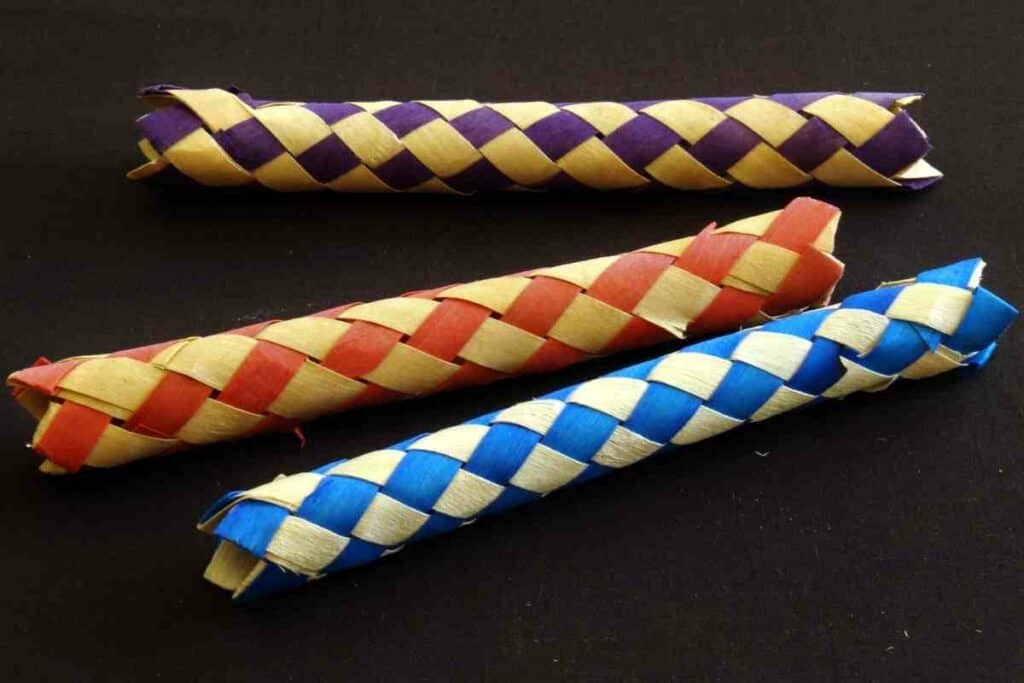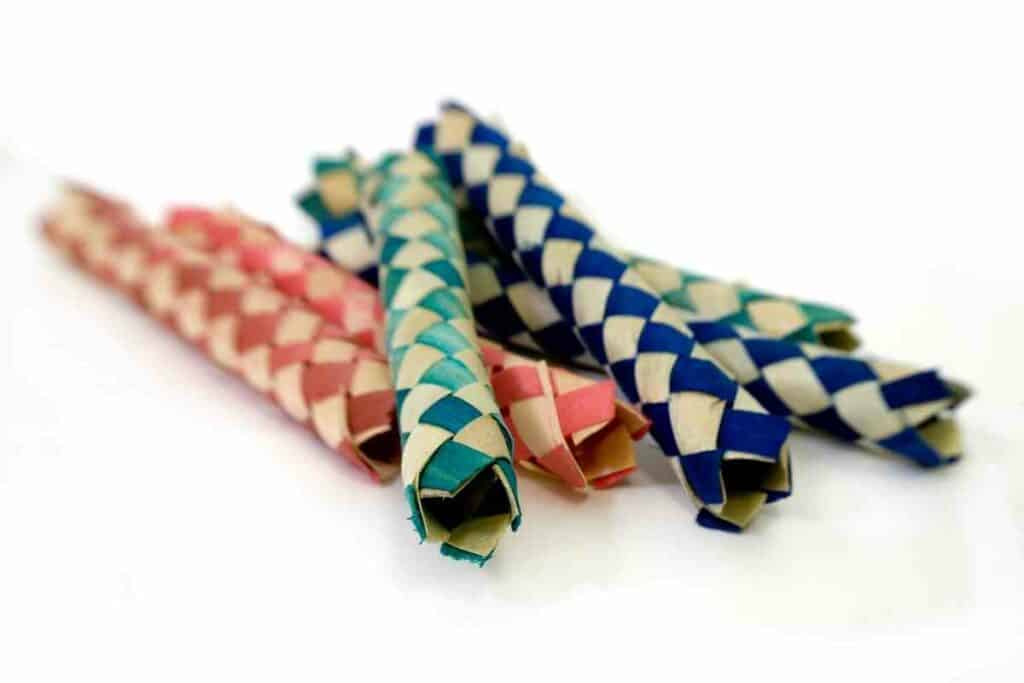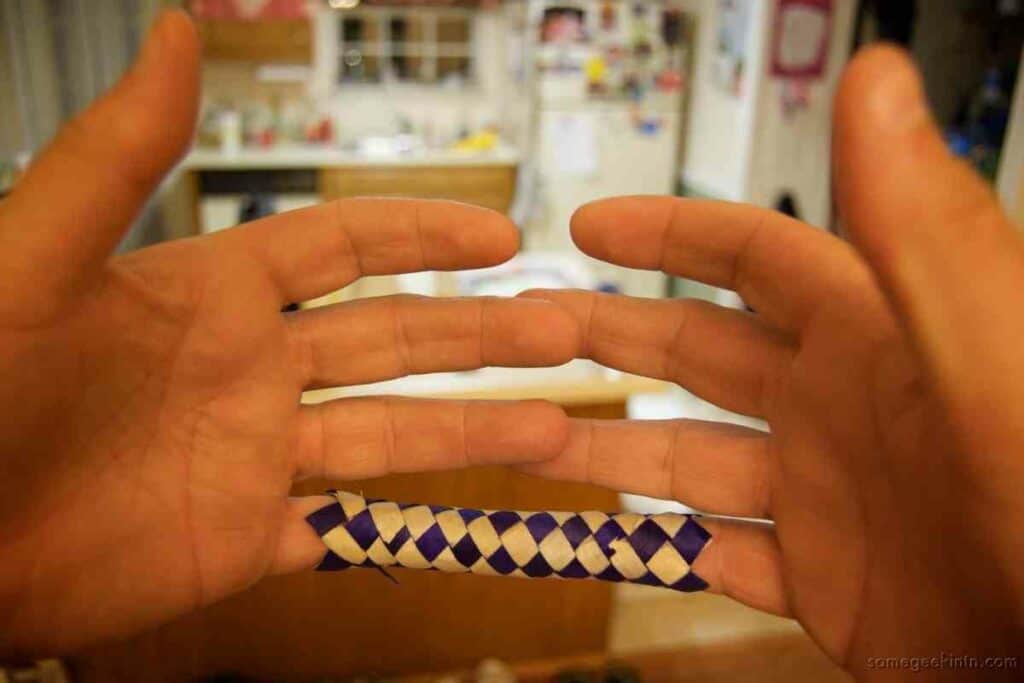From the written form of Japanese (Kanji – 漢字) to the order in which the Japanese write their names, Japanese culture finds much of its roots in ancient China.

The Finger Trapper was also originally Chinese and is known as a puzzle which has been widely available in two forms since the latter half of the 19th century.
What to Expect? This article will explain where this intriguing child’s toy came from, what it is used for, how it is made and the meaning which it carries. It will also detail further uses of this device.
Table of Contents
What Is a Finger Trapper?
Its definition is literally within the name: the Finger Trapper, Chinese Finger Trap, Thumb Puzzle, Finger cuff or even Chinese Handcuff, is designed as a puzzle which traps one of a person’s fingers in either end.

Fitting to any finger or thumb, it is usually applied to the index fingers.
The obvious goal is to break free from the trap but there is also a one-sided version known historically as the “Girlfriend Trap”, recorded as early as 1870, which also has a very telling name.
Boys would use this in centuries past, to show a girl that they wanted them to be their girlfriend.
How Is the Finger Trapper Made?
The Trapper is a form of braid and is formed by weaving strips of material like Bamboo, together, into a cylindrical shape known as a common Biaxial braid.
A tunnel, of sorts. When this completed braid is pulled, it tightens. The more it is pulled when encasing an object, the more the grip closes around it.

The only way to escape is to ironically push it further onto your finger and, once open, tightly grip it and it will come loose.
This is just the ordinary way in which this particular braid works but it can be applied in a number of ways, other than simply a finger trapping device.
Booking.comWho Invented the Finger Trapper and When?
The Finger Trapper’s origins are shrouded in mystery.
While some sources are determined that it was a Chinese invention by philosopher Lao Tzu, in the 6th century, others state that it was a much later invention in the West.

People in online forums, today, posit that it was an American invention by New Yorker: Joseph D. Antoni who apparently helped to raise its popularity in 1950s America.
This conflict of ideas causes much confusion, but it is easy to see that this was adapted from a much older concept when you learn of its uses around the world.
The Chinese Theory
Ancient philosopher Lao Tzu apparently created this device as a method of trapping prisoners of war in imperial China.
These must have been large enough to trap an entire arm and would likely have resembled some kind of straitjacket.
Evidence of this is difficult to find but there are many sources which state that this is a real connection to ancient China.
An ancient tale is told of these being used as cuffs to select worthy people for specific roles. Those who got stuck and let their emotions take over were deemed unworthy.
This is, however, unsourced but interesting all the same.
The Austrian Invention
The single-ended girlfriend trapper was used as a romantic gesture which demonstrates affection, but this use led an Austrian doctoral candidate to discover a new use for it, which we will return to below.
This was in the late 19th century and because it was a child’s toy there, prior to this, it must have been invented before this time.
The American Patent
Many associate the invention of this device with its general American use as a prank. A toy for both adults and children.
Very few sources exist for each assertion. The Finger Trapper was patented in America in 1956 but there are older records of it.
Does the Finger Trapper Carry Meaning?
In the majority, being considered to be a prank, this is something that would initially shock but then lighten a mood and make people laugh.

It was meant to bring some humor to a situation or, at least, annoy someone.
Philosophical Meaning
This device could be even more ancient than people believe.
Considering the ancient Buddhist concept of ‘Mottainai’ – the idea that all objects have an “essence” – there is likely a spirituality to it.
Something from which we can learn a lesson. It is basically a metaphor for the benefit of remaining calm in stressful situations.
If You Panic – Then you are likely to make any situation worse because you will inevitably stress out.
In this case, the trap creates panic in its victims; it just gets tighter and tighter the more you panic and try to pull at it, as a result.
A lesson in irony if nothing else, that is applicable to most stressful situations in everyday life.
Does It Have Any Other Uses?
Because of its natural ability to trap and grip objects, there are many varied uses for this nifty little device.
In 1870, in Vienna, for example: a dentist named Dr, Steinberger reported the doctoral work of one of his students; these centered around using the ‘Mädchenfänger’ (Girl Catcher) as a tool for surgery.
Used as a form of extension to grip blood vessels and arteries, referred to as the Extension Sleeve or ‘Schmall’sches Extensionsgeflecht’.
It is also used in many other situations as a towing tool. Gripping wires and cables to lead them through pipes and holes.
Final Thoughts
So, were Finger Trappers invented by the Japanese?
Possibly not, it would seem. It would be reasonable to presume that this device was, in fact, originally Chinese.
Based on the strong notion that much of Japanese culture is rooted in China; the fact that its most used pseudonym is the “Chinese Finger Trap”, and that an ancient Chinese philosopher made something similar, centuries before – I imagine you will make up your own mind.
However, the evidence is sketchy at best.
Also Read
- 12 Things Tourists Should NEVER Say in Japan
- Kissing Robot: Exploring the Popularity of the Chinese Kissing App
- Unlocking the Secret Dating Rituals Only Locals Know in Japan
- Samurai Armor: Ancient Protection for Japan’s Elite Warriors
- 10 Amazing Facts About Schools in Japan: Unique Traditions and Educational Practices
- Where can you see snow monkeys in Japan: Best locations and viewing tips









